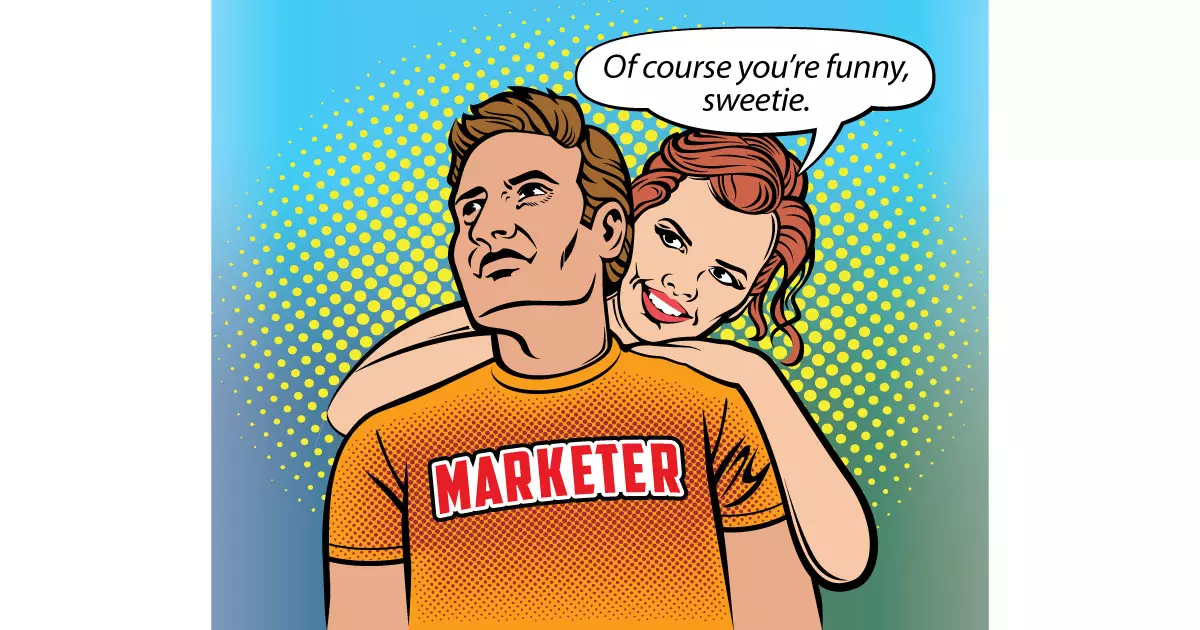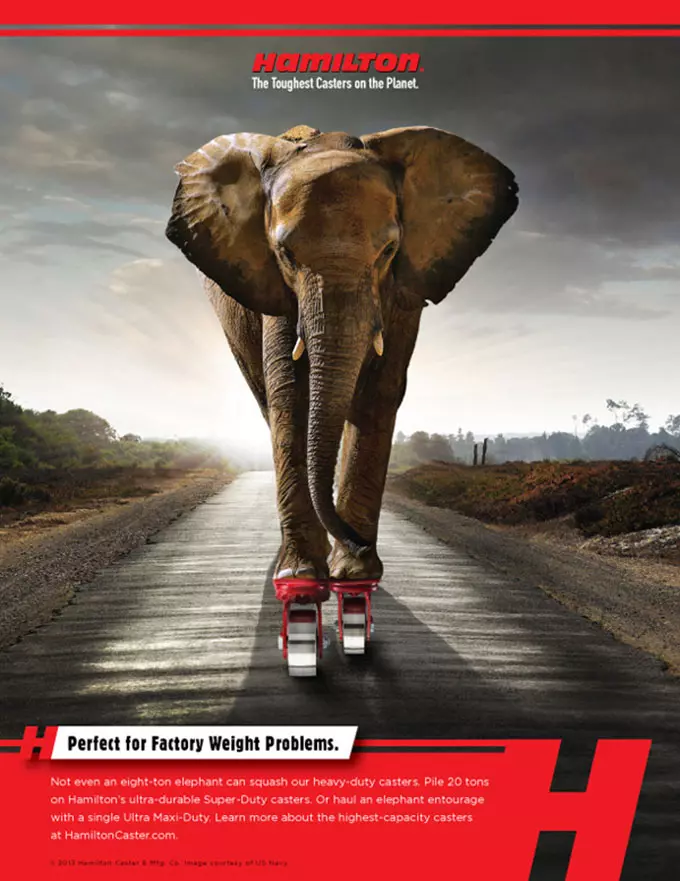Use Humor to Boost Engagement in Your B2B Content [EXAMPLES]

Create engaging, entertaining content by applying these three humor devices to your marketing efforts.
Why Use Humor in Your Marketing?
Imagine that you’re at a party. You meet three people while you’re there. One talks about the weather. Another complains about the food. And the third tells you a story that makes you laugh about their daughter. Which person do you feel connected to? Whose name do you remember?
When your content makes someone laugh, you’ve created an instant connection with them. And this connection can translate into bigger benefits for you and your brand.
Humor increases reach. According to a study conducted by the New York Times Customer Insight Group, there are several reasons people share content on social media and other platforms. One of the key motivations they identified was, “To bring valuable and entertaining content to others.” There are two words here that should speak to marketers — valuable and entertaining. When you use humor in your marketing, it’s important to strike a balance between being entertaining and bringing value to your audience. If the only thing they remember from your marketing is the joke, then your content hasn’t done its job effectively. Content that does achieve these two objectives is more likely to be shared, and thus, consumed by even more potential customers.
Humor encourages engagement. Your specific engagement goals can — and should — change based on the channel you’re using to promote your content. However, a very basic definition of engagement is when we, as marketers, succeed in getting our audience to take the action we want them to take, whether that’s sharing a post, browsing our site or buying our products. To encourage our audience to engage, we must first capture their attention, and then we must evoke a strong enough emotional response that they feel compelled to do something. Humor is one way to trigger an emotional response that prompts your audience to act.
Humor turns customers into fans. Because humor creates an instant human connection, it helps your customers feel an even greater affinity for your brand. When your humor lands and you make someone laugh (or at least smile on the inside), you’re showing your customers that you’re like-minded — in other words, you “get” them. This understanding can transform a customer from casual buyer to full-blown fan.
Humorous B2B Marketing Examples
B2C marketing has long relied on humor to connect with customers, whether it’s a swamp full of frogs selling beer or cavemen selling insurance. But B2B examples are a much rarer breed. Nonetheless, we were able to find a few to highlight, so let’s take a look and see why they work.
Zendesk: Bad Customer Service
Why It Works
Zendesk is a customer service software that touts itself as the best tool to help businesses deliver responsive, personalized support that improves customer relationships. This ad illustrates its value proposition by leaning into the exact opposite of great customer service, i.e., having to give your account information 15 times, being rerouted through multiple departments and even landing on an unending hold line with cheesy music.
But the real kicker for this ad isn’t the recognizably bad customer service. We’d understand if this experience happened to someone calling their insurance company or a big-box retailer. No, the surprising part about this ad is that it happens to a person who’s calling her parents. So, while on the surface this ad is about better customer service, the underlying message is that when you work with Zendesk, you’re going to make your customers feel as valued as your own family. Assuming your own family doesn’t have an automated phone system like the one in the ad.
Hamilton Casters: Toughest Casters on the Planet

Why It Works
This ad is simple. There’s not much going on here, and at first glance, it basically looks like an elephant wearing roller skates. But when you look closer, you notice the ad is for a caster company. Suddenly, your neurons begin firing and before ever reading the subhead, you understand that these aren’t just ordinary casters — they’re casters that can carry some of the world’s heaviest things.
After hooking readers with the elephant, the ad goes on to say (and I’m paraphrasing), “Oh hey, you thought elephants were impressive? Think again. These casters can haul a whole entourage of elephants.” That’s a pretty powerful message, and although this ad might not be laugh-out-loud funny, it manages to surprise and delight without requiring a lot of work on the part of the viewer.
Intel: Sponsors of Tomorrow
Why It Works
This series from Intel is presented in bite-size clips that all roll up under the same idea: we do things differently because we employ people who think differently. And how better to demonstrate that idea than to drop Intel employees into ordinary situations and observe what they do? From cutting cake at a party to telling jokes and doodling, these ads highlight how Intel employees see the world through a different lens. The simple tagline is a repeatable but changeable element that also helps underscore the message that Intel is a company full of geeks who like to have a little fun.
Applying Humor to B2B Marketing Creative
So, now that we’ve looked at a few humorous ads, let’s talk about how you can apply the same humor devices to your B2B marketing creative.
HUMOR DEVICE #1: INCONGRUITY
As a humor device, incongruity means doing something unexpected under normal circumstances. In the case of the Zendesk video, it was a person being routed through ridiculous customer service protocols just to speak to her parents.
I’m not saying you should always lean into a scenario that’s the exact opposite of your value proposition, but I would advocate for brainstorming ways to take your audience by surprise. Incongruity can be a powerful tool to capture your audience’s attention, especially when it’s applied in a way that feels authentic to your brand.
Writing exercise for applying incongruity
1. Write down your core idea — a short sentence that states what you’d like your customers to know after seeing your creative.
2. Brainstorm a list of words that come to mind as you consider your core idea.
3. Using your words as a starting point, begin to make associations until you land on a scenario.
4. Think through ways you could use that scenario to demonstrate your core idea.
An example for Zendesk might look like this:
You wrote down “better customer experiences” because that’s what Zendesk delivers. How do they do it? Well, they take away the annoying things about calling customer service — things like long waits, being transferred and repeating your account information. They make customers feel like they’re calling someone who actually wants to talk to them. Who can you normally call who always picks up the phone and wants to talk to you and will likely be overly helpful? Your parents. So, what if we showed someone calling their parents and having to go through the same annoying customer service protocols?
HUMOR DEVICE #2: ASSOCIATION
Association is the process of connecting two ideas in language, in visuals or by playing them off each other in a clever way. Think back to the Hamilton casters example. We all know that an elephant is heavy, and we all know what wheels look like. But did you ever expect to see an elephant on wheels? Probably not.
The important thing to remember when using this humor device is that both pieces must unmistakably represent the two things you want to associate. Unclear associations can leave your audience confused and uninterested.
Writing exercise for applying association
1. Write down your core idea — a short sentence that states what you’d like your customers to know after seeing your creative. (You’ll see a pattern here.)
2. Split the page into two columns, one for your product or service and one for the biggest benefit it brings to your customers.
3. Beneath your product, list recognizable attributes of your product or service. Beneath the benefit, list images or words related to the benefit.
4. Match options from your product list with options on your benefit list to create a surprising combination.
An example for Hamilton casters might look like this:
| Product: Casters | Benefit: Can handle very heavy items |
|---|---|
| Used to move things | Strong man competitions |
| Metal | Elephants |
| Heavy-duty | Freight train |
HUMOR DEVICE #3: OBSERVATION
Our last humor device is observation, and it’s the broadest of the devices covered in this post. Observation is simply a reference to something most of your audience is aware of. The reference might be to a world event, a well-known piece of pop culture or, if applicable, to something previously mentioned within the series. The Intel ads, for example, are a nod to engineering, IT and other “geek cultures.” But instead of poking fun, Intel celebrates the geek mindset, showing that geeks are what give the company its edge. The predictable tagline also makes these ads feel like a cohesive story.
A word of caution with using observation — because your content will reference something timely, it may have a shelf life. This shouldn’t discourage you from using this device, but it does mean you should carefully evaluate how you plan to use the piece of content in the future before you develop it.
Writing exercise for applying observation
1. Write down your core idea — a short sentence that states what you’d like your customers to know after seeing your creative. (Yep, there it is again.)
2. Separate your page into three columns called: Words/Phrases, Entertainment, Events.
3. List items that are currently popular in each of those categories.
4. Brainstorm ways to connect your product to something on your list.
An example for Intel might look like this:
| Words/Phrases | Entertainment | Event |
|---|---|---|
| Yeet | Silicon Valley | Comic conventions |
| It me | The Office | Work parties |
| Star Wars |
Applying humor to your marketing is a gamble, so it’s important to understand your audience and carefully consider just how far you should push your content. Remember, we always want to deliver entertainment without sacrificing value. Now — go make it funny.
Sign Up for our Newsletter - Get agency updates, industry trends and valuable resources delivered directly to you.
Godfrey Team
Godfrey helps complex B2B industries tell their stories in ways that delight their customers.




